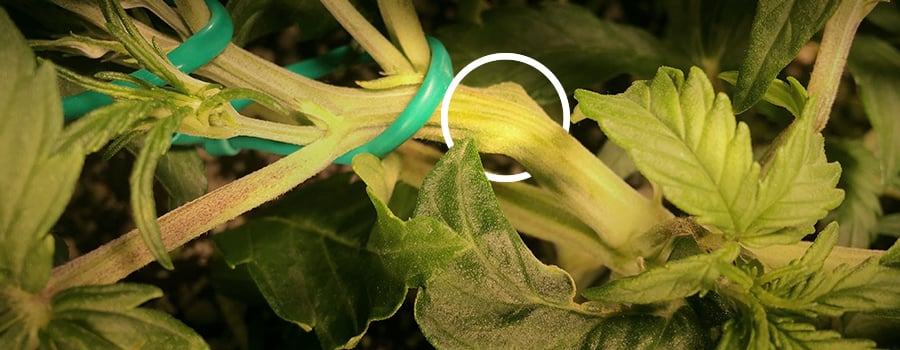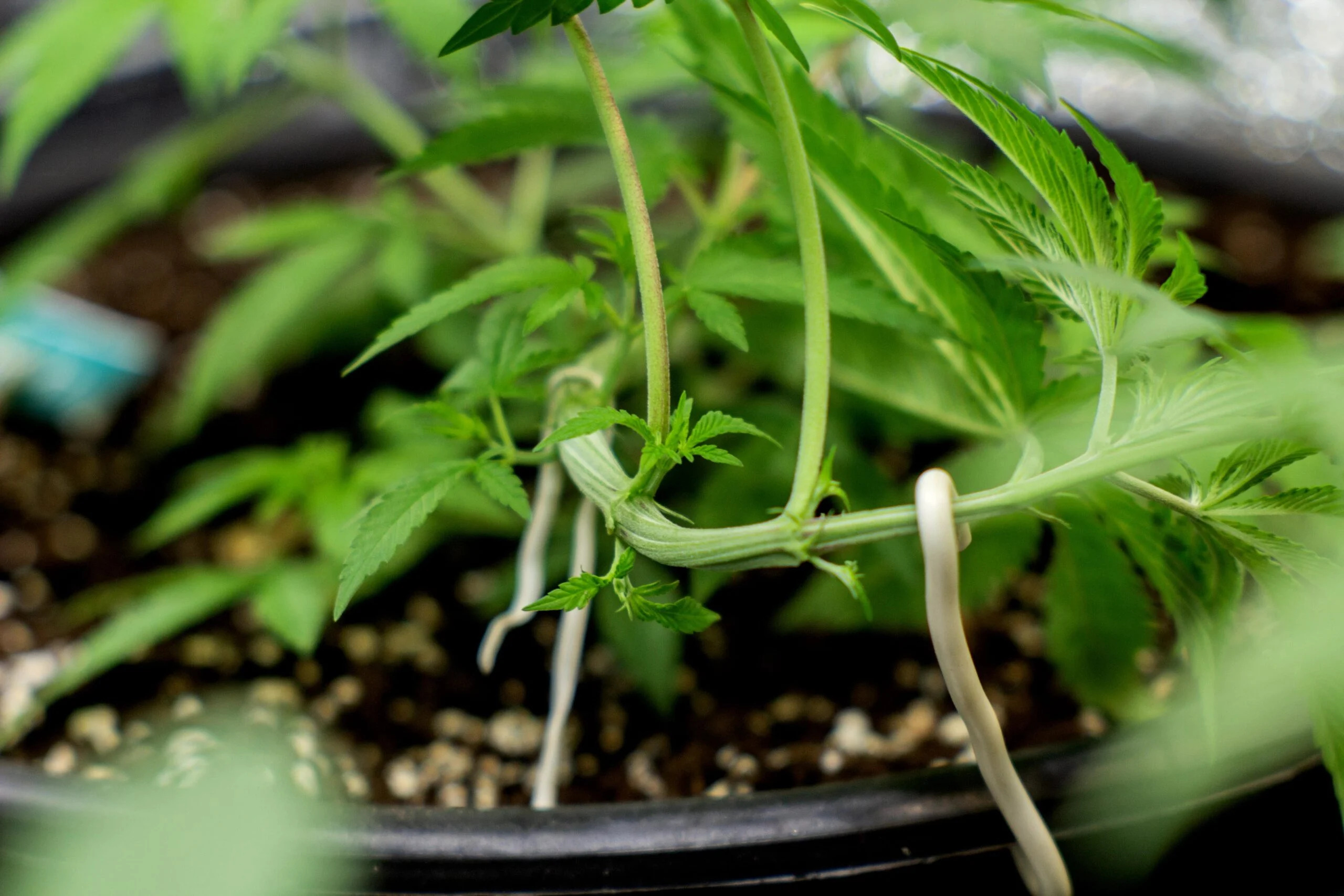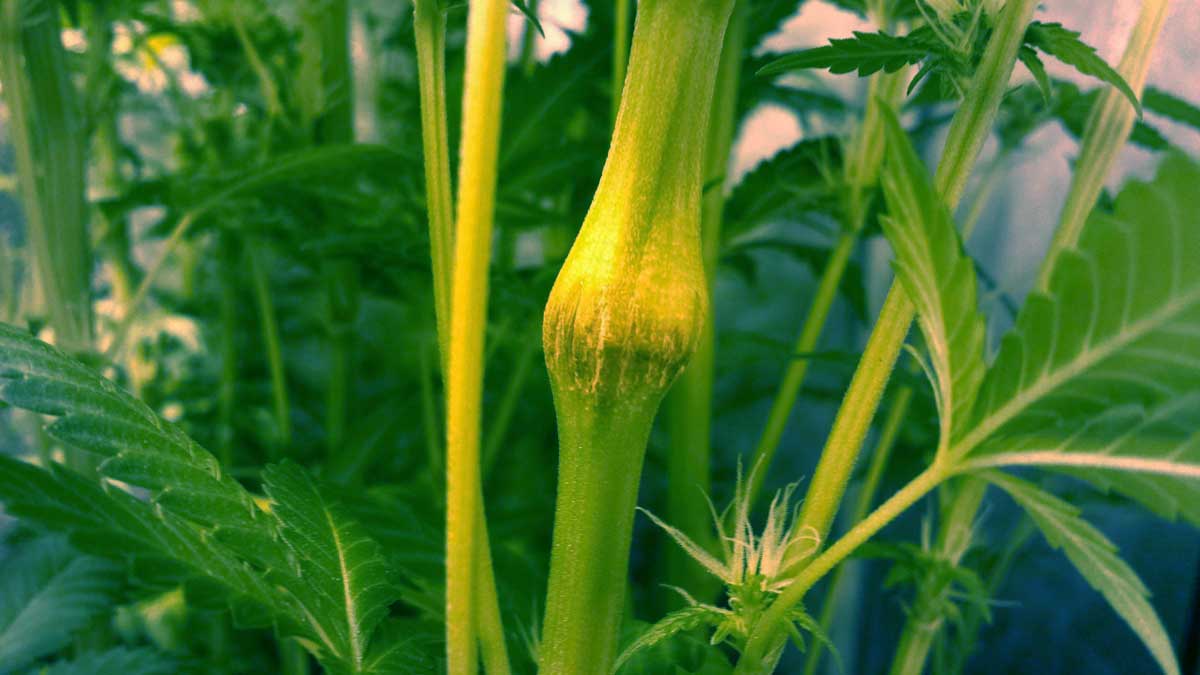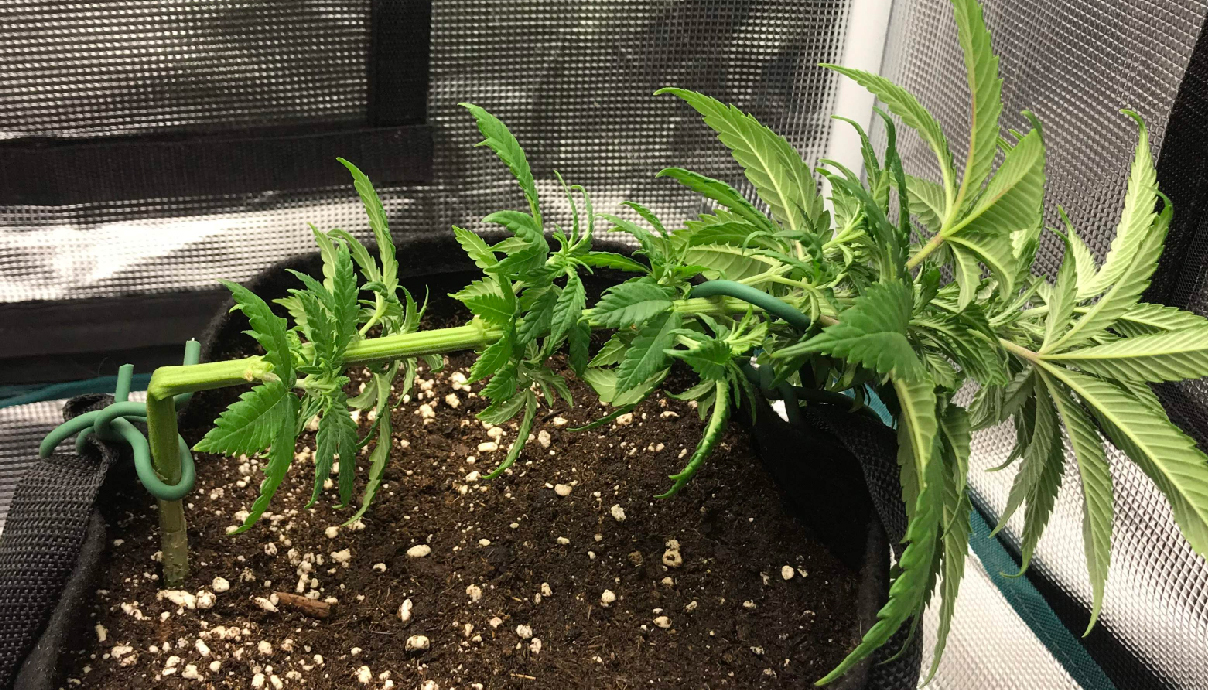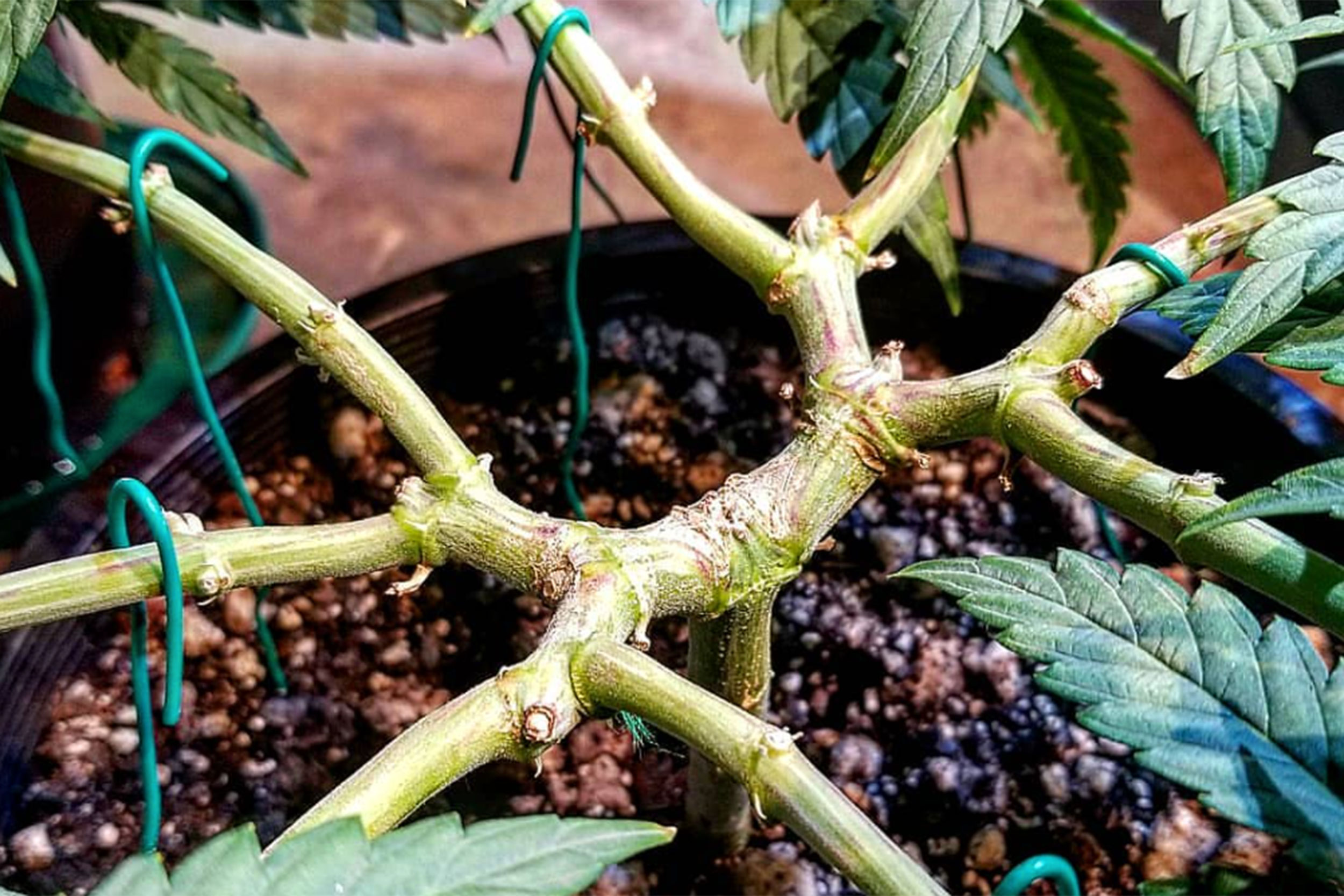Qu’est-ce que le "Supercropping"?
Le supercropping est la pratique consistant à manipuler vos plantes de cannabis pour améliorer leur santé, leur rendement et leur qualité. La technique relève du terme High-Stress Training (HST) et peut être utilisée pour donner un avantage aux plantes.
Même si certaines techniques sont plus stressantes que d’autres, il s’agit avant tout de bien organiser la structure physique de votre plante pour qu’elle fonctionne plus efficacement. Cela implique de plier soigneusement les branches, d'entraîner les membres ou de déplacer les tiges pour créer un stress minimal mais une récompense maximale pour vos plantes de cannabis.
Cela peut sembler contre-intuitif, mais ce type spécifique de taille va très loin, permettant aux gens d'organiser la forme générale de leur jardin, de configurer correctement les éléments clés tels que la circulation de l'air et les sources de lumière, de simplifier les tâches d'entretien et, surtout, d'augmenter les rendements plus lourds. à partir d’une seule plante.
Avantages et inconvénients du "Supercropping" en culture du cannabis
Le supercropping est une technique de palissage très stressante utilisée par les cultivateurs de cannabis pour maximiser les rendements et encourager une croissance plus touffue. Cela implique de plier et de pincer doucement les tiges pour endommager les tissus internes de la plante, ce qui déclenche une réponse favorisant la croissance. Le supercropping présente des avantages et des inconvénients, qui doivent être soigneusement étudiés avant de mettre en œuvre la technique.
Avantages:
- Rendement accru : le supercropping peut potentiellement augmenter le rendement en encourageant davantage de sites de bourgeonnement et en répartissant plus uniformément les hormones de croissance dans toute la plante.
- Meilleure pénétration de la lumière : en créant une canopée plus uniforme, le super recadrage permet une meilleure répartition de la lumière, garantissant que toutes les parties de la plante reçoivent suffisamment de lumière pour une croissance optimale.
- Tiges renforcées : Le processus de guérison qui suit le supercropping donne des tiges plus épaisses et plus robustes qui peuvent mieux supporter les têtes lourdes.
- Hauteur contrôlée : le super recadrage aide à gérer la hauteur des plantes, ce qui le rend idéal pour les espaces de culture en intérieur avec un espace vertical limité.
- Adaptabilité : Cette technique peut être utilisée sur diverses variétés de cannabis et à différents stades de croissance, offrant aux cultivateurs expérimentés une flexibilité dans leur approche de culture.
Inconvénients:
- Réponse induite par le stress : Le supercropping est une technique très stressante, et toutes les plantes ne réagissent pas bien au stress. Les plantes trop stressées peuvent présenter un retard de croissance, des rendements réduits ou même mourir.
- Expertise requise : Réussir une culture de cannabis nécessite un certain niveau de compétence et d’expérience pour éviter de causer de graves dommages à la plante.
- Temps à consacrer: Cette technique peut demander beaucoup de travail et nécessite une surveillance et des ajustements réguliers pour obtenir les résultats souhaités.
- Potentiel d'infection : endommager les tissus de la plante l'expose à des infections potentielles, ce qui peut avoir un impact négatif sur la santé et le rendement de la plante.
Quand commencer le "Supercropping"
Démarrer une technique de supercropping est important pour maximiser le potentiel de votre plante, mais il est également nécessaire de savoir quand commencer le processus. C’est au début de la phase végétative que la taille sélective des feuilles a généralement lieu. Ici, vous devrez attendre que votre plante mesure entre 10 et 12 pouces de hauteur avant d'essayer de la casser et de la tordre sans risquer de graves dommages.
Une fois que votre plante a poussé suffisamment, il est temps de procéder au super recadrage. Cependant, gardez à l'esprit que la plupart des super récoltes devraient avoir lieu pendant la phase végétative, car la phase de floraison est plus susceptible de consacrer son énergie à la floraison plutôt qu'à l'optimisation de la récupération des tiges raides.
Ainsi, en suivant ces quelques conseils essentiels, vous pouvez vous assurer de démarrer votre méthode de supercropping au bon moment et aider votre plante à retrouver la meilleure forme possible !
À Lire Plus: Le guide ultime du fluxage du cannabis
Quelles sont les principales techniques de supercropping ?
Le supercropping est une approche innovante de la culture du cannabis qui consiste à manipuler la croissance des plantes pour optimiser les rendements précieux et la santé globale. Pour maximiser les avantages de cette méthode de palissage très stressante, les cultivateurs de cannabis en extérieur emploient diverses techniques, chacune conçue pour répondre à des besoins et à des conditions de culture spécifiques.
Taille sélective des feuilles
Les techniques de supercropping sont un excellent moyen d’augmenter le feuillage et les énormes rendements de vos plants de cannabis. Une méthode efficace pour obtenir ces résultats est la taille sélective des feuilles. Avec cette technique, vous pouvez éliminer les feuilles créatrices d’ombre qui recouvrent les nœuds ou les sites de bourgeonnement, permettant ainsi à votre plante d’accéder à plus de lumière et d’espace pour sa croissance.
De plus, toutes les feuilles intérieures qui pointent vers l’intérieur vers l’auvent peuvent également être retirées en toute sécurité sans aucun outil ; pincez-les simplement entre votre pouce et votre index et retirez-les avec un mouvement ferme vers le haut.
Taille des branches et des nœuds
La taille des branches et des nœuds est un moyen efficace d’augmenter le rendement d’une plante, lui permettant de diriger l’énergie exactement là où elle est nécessaire. Lorsqu'une plante grandit, elle produit souvent des branches drageons qui lui enlèvent de l'énergie sans aucun bénéfice intéressant en raison du manque d'exposition à une lumière intense.
La suppression de ces branches fragiles et cassées permet à l'énergie qui y est stockée d'être redistribuée vers les autres parties des plantes qui reçoivent une exposition directe à la lumière. Cela permet à ces autres parties de la plante, y compris les sites de bourgeonnement et de ramification situés plus haut sur la plante, de bénéficier d'un meilleur accès à la lumière du soleil et à la chaleur.
Le même principe peut également être appliqué aux nœuds, qui commencent dans les crevasses où les tiges des feuilles rencontrent les tiges principales, pour finalement former une autre branche. En supprimant sélectivement les nœuds non essentiels, un sécateur peut diriger la croissance vers les parties supérieures de la plante qui reçoivent une exposition directe à la lumière.
L'élagage des nœuds d'aspiration ainsi que des branches permet de garantir que toutes les zones de votre jardin ou de votre jardinière disposent de suffisamment de ressources pour une croissance sans stress. La taille des nœuds doit être effectuée avec soin afin de ne pas endommager d'autres parties de vos plantes lors de la suppression des parties inférieures ; sinon, vous risquez de provoquer un stress supplémentaire qui peut arrêter ou ralentir complètement la croissance.
"Topping" et formation
L’une des techniques les plus populaires parmi les cultivateurs de cannabis est le topping. L'étêtage consiste à couper la tête la plus haute au sommet de la plante, permettant aux branches inférieures d'obtenir des niveaux de lumière égaux et de devenir des têtes plus grandes.
Cette méthode fonctionne dans la mesure où les plants de marijuana ont tendance à concentrer toutes leurs hormones de croissance sur un seul sommet ou sur la pointe la plus élevée pour dépasser tout ce qui les entoure. En étêtant, vous supprimez le sommet et laissez toutes vos autres branches recevoir plus d'énergie du soleil et croître de manière égale.
Au lieu d’avoir une branche centrale qui bénéficie de toute la bonne intensité lumineuse, vos branches satellites y ont désormais également accès. Après avoir étêté votre plante, elle continuera à se ramifier avec deux sommets qui repousseront éventuellement, créant ainsi une formation d'apparence plus touffue que celle qui existait à l'origine. L'étêtage peut aider à augmenter considérablement le rendement des têtes s'il est effectué juste au bon moment pendant la phase de floraison, ce qui vous donnera une récolte assez riche.
Casser et tordre
Le claquement et la torsion sont une technique de super recadrage qui a un impact extrême et rapide sur les plantes de cannabis. Cette compétence difficile nécessite un équilibre précis de mouvements fermes mais délicats : les utilisateurs doivent saisir la branche avec les deux mains et la tourner dans des directions opposées jusqu'à ce qu'ils sentent et entendent le claquement briser la poussée intérieure, laissant la couche externe intacte.
Le processus de guérison commencera alors et durera environ 24 heures, ce qui entraînera une plus grande fortification de l'endroit spécifique où la plaie a été créée. Le principe derrière cette technique est similaire à celui utilisé lorsque les humains se cassent les os : une fois réparés, ils renforcent cette même zone car ils ne pourront plus jamais être brisés à cet endroit précis.
Cela fait du cassage et de la torsion un excellent choix pour les experts en cannabis qui souhaitent renforcer la force et la résilience de leur culture sans recourir à des traitements chimiques. Des techniques de super culture correctement exécutées peuvent contribuer à garantir des plantes plus saines à long terme tout en évitant des processus plus invasifs tels que l’étêtage ou la taille.
Guide de "Supercropping" : comment faire sur vos plantes
Cette méthode de palissage très stressante peut augmenter les rendements et améliorer la croissance globale lorsqu’elle est exécutée correctement. Apprenez les étapes et conseils essentiels pour superculturer des plantes de manière efficace et en toute confiance.
Choisissez les branches
Le supercropping est un moyen simple et efficace d’augmenter le rendement de vos plants de marijuana. Cette technique consiste à exercer un stress physique sur certaines branches de la plante pour les forcer à pousser plus horizontalement et de manière plus touffue.
En faisant cela, vous pouvez créer une canopée avec beaucoup plus de fleurs et de bourgeons, conduisant à des rendements plus élevés. Lors du supercropping, il est préférable de le faire pendant la croissance végétative, lorsque les branches saines sont encore vertes et souples.
Vous devriez choisir les branches les plus anciennes qui existent depuis un certain temps, car elles seront suffisamment résistantes pour la technique de super recadrage. Assurez-vous de ne pas choisir des branches trop faibles, sinon vous pourriez les casser complètement.
Plier les branches
Les branches courbées sont un processus qui peut être utilisé pour diriger la croissance des plantes et des fleurs. Il s'agit d'une technique, appelée super recadrage, qui consiste à endommager les tissus internes d'une plante pour créer des tiges plus souples et plus flexibles.
Cela permet à ceux qui souhaitent sculpter leurs plants de marijuana ou diriger leur croissance dans les formes souhaitées de le faire sans endommager ou casser complètement la couche externe.
Pour que cette technique avancée fonctionne correctement, la pression doit être appliquée correctement lorsque vous pressez doucement les branches à l'endroit où vous souhaitez qu'elles se plient. Vous devez ensuite lentement tordre cette ramification entre vos doigts pendant environ dix secondes jusqu'à ce qu'elle commence à être plus douce et souple.
Collez toutes les fentes dans les branches si nécessaire
Le Supercropping de plantes de cannabis est un excellent moyen de produire de gros rendements de têtes ; cependant, cela peut être délicat et des erreurs peuvent survenir. Si la peau externe de la branche se déchire, mettez le masque de votre médecin et appliquez du ruban adhésif pour encourager la tige à rester en place et à continuer de fonctionner comme d'habitude.
Avec du ruban adhésif renforçant la tige, elle continuera à transporter les carences en nutriments comme d'habitude tout au long de son cycle de croissance et aidera à favoriser la guérison de la plante.
Après environ sept jours environ, vérifiez le joint pour déceler tout signe de blessure ou de décoloration restante à partir de l'endroit où vous avez appliqué le super recadrage. S’il y a encore des traces de blessures, ajoutez un autre pansement et attendez encore quelques jours jusqu’à ce que votre cannabis développe sa « jointure » protectrice.
Si votre plante tente de se redresser, attachez-la avec une technique d'entraînement à faible stress (LST) pour la renforcer. Enfin, si vous cassez accidentellement des branches lors du super recadrage, enroulez du ruban adhésif autour de cette zone jusqu'à ce qu'elle soit complètement cicatrisée. Savoir gérer correctement toute rupture ou casse peut vous faire gagner du temps et de l’anxiété à long terme !
Des rendements meilleurs et plus importants
Le supercropping est une technique de culture couramment utilisée dans les plants de marijuana pour produire des rendements plus importants tout en économisant de l'espace. En utilisant cette technique pour manipuler la portée du sol, la distribution de la lumière et les restrictions de hauteur, les producteurs avancés peuvent optimiser le rendement de leurs cultures et obtenir des résultats de meilleure qualité.
La superculture donne des plantes fortes avec une structure plus touffue et une robustesse améliorée grâce aux nœuds plus épais trouvés sur les ramifications. Avec cette méthode, les cultivateurs professionnels se retrouveront avec une hauteur de plante globalement inférieure mais des rendements plus élevés en raison du nombre plus élevé de têtes et de branches résultant de ces branches secondaires encouragées par la superculture du cannabis.
Derniers points sur le Supercropping
Le supercropping est une technique d’entraînement à stress élevé (HST) incroyablement utile qui peut être utilisée pour créer une culture de cannabis plus prolifique. Il fonctionne en stressant involontairement la plante, puis en la manipulant pour concentrer son énergie sur l'épaississement de ses tiges plutôt que sur sa hauteur.
Cela crée une plante beaucoup plus dense et plus touffue avec plus de sites de floraison par rapport à une plante conventionnelle non altérée. En faisant cela, votre récolte sera globalement plus importante en raison du nombre accru de sites de têtes créés à partir du supercropping.


 English
English 